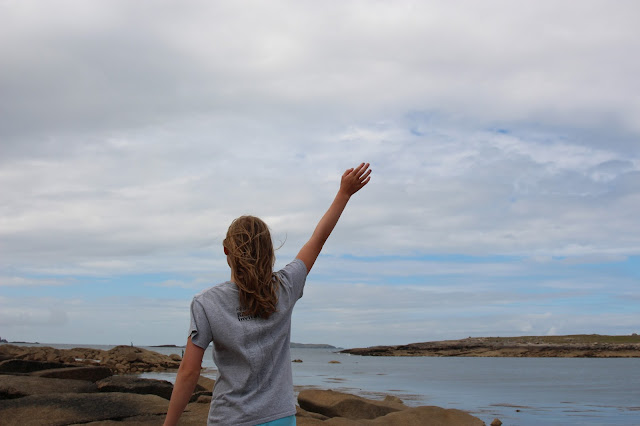 |
| Apple Prints |
 |
| I added the blossom end and the stalk with my paint brush |
Ich träume von einem eigenen Apfelhain. Irgendwann sicher! Aber bis dahin wird mich hoffentlich dieser Druck erfreuen, der viel einfacher zu bekommen ist als ein Obstgarten.
Dafür einen Apfel nach Wahl aussuchen (Form geht vor Geschmack in diesem Fall) und der Länge nach halbieren.
Die Schnittfläche muss absolut gerade sein! Ansonsten wird es nichts mit einem sauberen Druck.
Dann Farbe auf die Schnittfläche auftragen und drucken. Ich habe dafür Acrylfarbe genommen.
Wer sich an großformatige Projekte wagt, dem empfehle ich mit verschiedenen Farbaufträgen und mit unterschiedlichen Körpereinsatz beim Drucken zu experimentieren. Die Ergebnisse werden recht unterschiedlich ausfallen.
Die Apfelstiele habe ich mit Pinsel hinzugefügt. Und für den Schriftzug habe ich einfach Buchstabenstempel benutzt. Dieser ist nicht perfekt geworden, stört mich aber (noch) nicht.
Übrigens lassen sich mit den bedruckten Papieren (evtl. den "Fehldrucken") auch wunderbar Geschenke einpacken. Oder Karten basteln.
Für alle Bewegungsinteressierten noch der Hinweis, dass Drücken eine der Labanschen Effort- oder Antriebsaktionen ist.
Diese ergeben sich aus den verschiedenen Kombinationen der von Laban entschlüsselten Bewegungsfaktoren nämlich Zeit (allmählich - schnell); Schwerkraft (fest/stark - zart/leicht) und Raum (direkter oder flexibler Raumweg).
Das heißt im Falle des Drückens (das gleiche gilt für Pressen oder Schneiden):
Wir bewegen uns allmählich (Zeitfaktor), wir drücken fest (Krafteinsatz) und zwar entlang eines direkten Raumpfades.
Nun aber genug mit der Theorie! Viel Freude beim Drücken und Drucken!
I would love to have my own apple orchard - hopefully one day my dreams come true. Until then I will enjoy the apple prints we made. There are super easy as all you need is an apple, acrylic paint, brushes, a knife and paper.
Cut an apple in two halves. The cut need to be absolutely straight - no bumps etc. Otherwise the print will not be clear.
Put paint on one of the halves. Colour is your choice. I used green with a bit of yellow as well as red.
Play around with the amount of paint and pressure needed when you print as you will get various results. However, after some miscellaneous prints you will have figured out! Use those prints for wrapping gifts. I think this looks fabulous too.
I added the blossom ends and the stalks with my paintbrush - hence these apple piece weren't printed.
I used letter prints for my "You are special" print. This turned out not to be perfect, but I decided it is okay (for now).
The little project is suitable from the age 3+. My one year old joined into the printing party, but it was quite challenging to convince him not to put the apple with paint into his mouth...
For all of you who are interested in dance and Rudolf Laban, you might like to know that the movement "press" (which you need for printing obviously) is one of the Eight Effort Actions or Effort Drives.
Effort or the dynamics of movement consists of different combinations of the 3 motion factors namely:
Time: sudden and sustained
Space: direct and flexible pathways
Weight: strong and light
Therefore, when we print (press) the timing is sustained, pathway is direct and you have to use a good bit of weight in order to create an even print.
And now do not only enjoy the printing result, but the accompanying movement too!
This post is linked with www.creadienstag.de.









